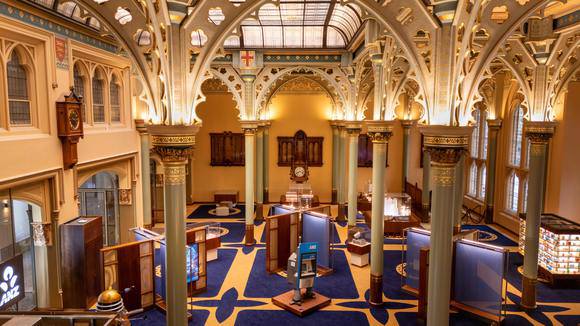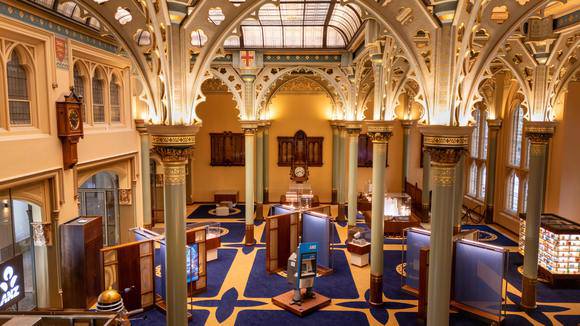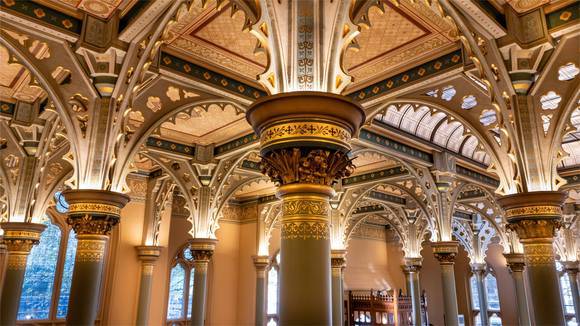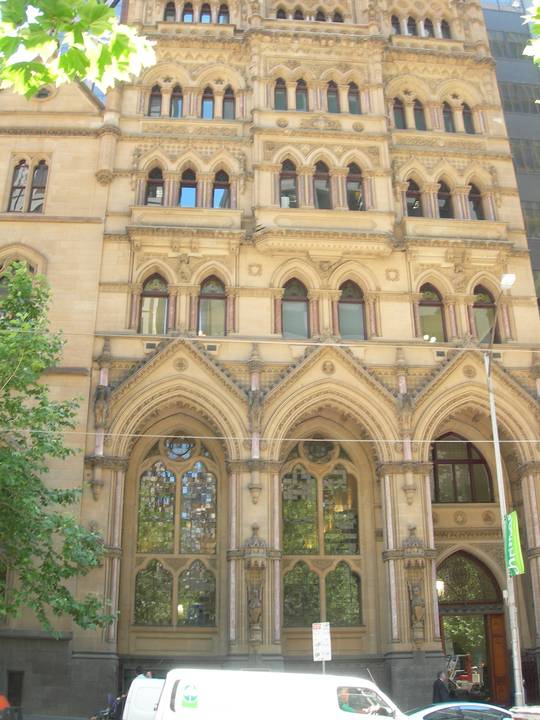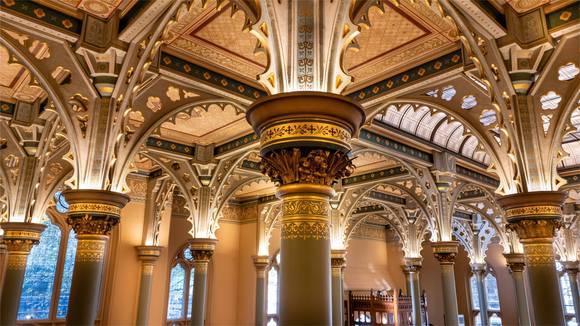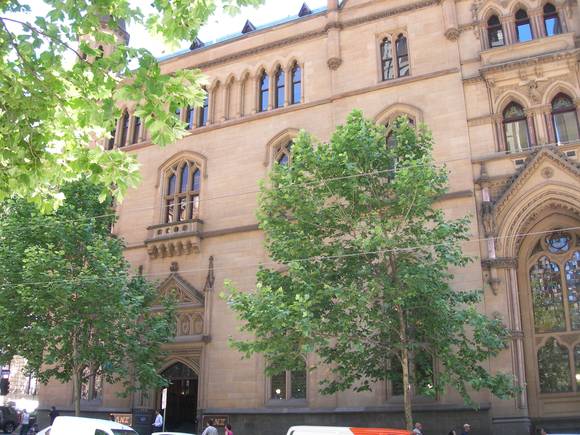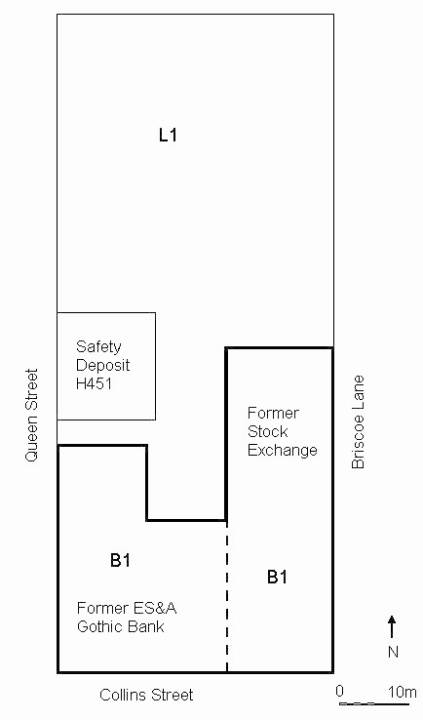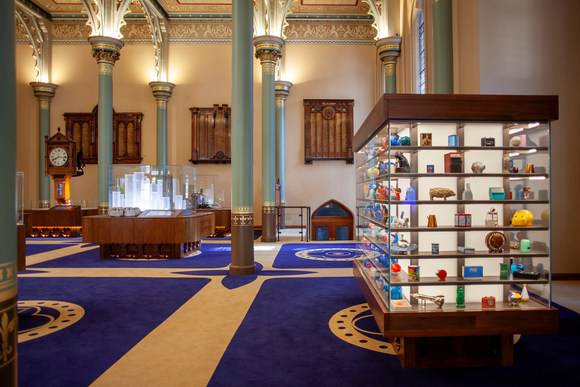| Back to search results » | Back to search page » |
|
ANZ BANK
Other NamesLYCEUM CLUB , GOTHIC BANK AND MELBOURNE STOCK EXCHANGE , FORMER MELBOURNE STOCK EXCHANGE , Former English, Scottish & Australian Bank , ANZ GOTHIC BANK , ES&A BANK Location376 - 390 COLLINS STREET MELBOURNE, MELBOURNE CITY
File Number601914 [ 1 - 4 ]LevelRegistered |
|
Statement of Significance
What is significant?
The ANZ Bank building at 376-392 Collins Street Melbourne, is anamalgamation of two buildings: the former ES&A 'Gothic' Bank, on thecorner site, and the former Melbourne Stock Exchange, fronting CollinsStreet. While both these designs are specifically Gothic in style, theirappearance is a demonstration of the two vastly contrasting Gothicrevival developments in Melbourne during the 1880s and 1890s. The GothicBank was the first building to be constructed and is an example of thefirst Gothic style. It was designed by William Wardell, to fairlydetailed specifications laid out by the General Manager, Sir GeorgeVerdon. The style is restrained externally, and internally graceful andornate. It is secular Gothic, although Wardell had previously made aname for himself through church architecture. Goss & Mason were thecontractors and Alexander Todd was appointed as Clerk of Works. Theworks began in 1883 and the building was opened in May 1887, a yearlate. The final cost was over £77,000, almost twice the budget. Theentire ground floor was established as the banking chamber, and thefirst and second floors as a residence for the General Manager. SirGeorge Verdon moved into the residence in 1888 and remained there untilhis retirement. In 1934 the Lyceum Club leased these rooms and used themuntil 1957.
The former Stock Exchange was designed by the Melbourne architect William Pitt and was constructed in 1887. The style has been labelledFree Gothic and is far less restrained than the earlier building. Thefacade is extremely ornate and each level has been designed differently.Pitt was one of the best known executors of this new Gothic style inMelbourne, who at the time received criticism from more conservative designers. The total cost of the building, including the land, was£254,000. Overall the land purchase and building construction were apoor investment and in 1921 the Stock Exchange, due to financialdifficulties, was forced to sell its property back to the ES&A Bankfor only £136,500. The main trading floor for the Stock Exchange was onthe ground level in a large vaulted chamber, known as the Cathedral Room. This room was designed with the reverence and grace of a church,an impression emphasised by the vaulted roof and the stained glass windows. In 1923 the bank renovated the site to combine the two buildings, thus enlarging the Banking Chamber, leasing the offices and running the Safe Deposit.
How is it significant?
The ANZ Bank at 376 - 392 Collins Street Melbourne is of architectural,historical and social significance to the State of Victoria.
Why is it significant?
The ANZ Bank is architecturally significant as the first ES&A Bankto be designed in the Gothic style that was to become a trademark forthe banking corporation. It is also significant for the scale and ornategrandeur of both the interior and exterior, resulting in it beingconsidered one of the finest buildings in Melbourne at the time of itsconstruction. The Gothic Bank and former Stock Exchange are ofarchitectural significance through their association with the prominentMelbourne architects William Wardell and William Pitt. The Verdonchambers within the Gothic Bank are architecturally significant fortheir extensive size and grandeur. The 1921 alterations to the bank aresignificant as they represent an interesting solution at the time ininner city expansion; that being renovation and interior redesign ratherthan rebuilding. The Cathedral Room within the Former Stock Exchange isarchitecturally significant as a largely original, and very ornate,example of a public business arena.
The ANZ Bank is historically significant as the banking headquarters ofthe ES&A Bank, positioned on a corner site within the centre of thebanking precinct in Melbourne, which was the most important business centre at the time in Australia. This building is also significant forwhat it illustrates of the banking boom during the 1880s and thesubsequent depression of the 1890s. The former stock exchange was builtfar beyond its means and was never able to recoup the financial outlayof the enormously expensive building. The former residence of the General Manager of the ES&A Bank, on the first and second floors of the Gothic Bank, is significant as the only intact example of an inner city banking residence from the 1880s in Melbourne.
The Gothic bank is socially significant as the site of the Lyceum Clubrooms for 32 years. The Lyceum Club was established in 1912 for women who demonstrated an ability or commitment to the areas of philanthropy, arts, community service, education, medicine or science, writing or music.
Group
Commercial
Category
Bank


